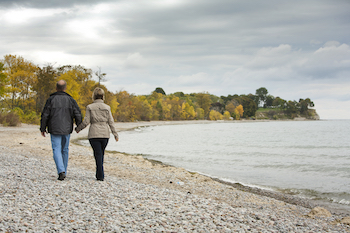What is sexual incontinence?
This problem refers to leaking urine during sex and may be seen after radical prostatectomy. There are two specific types.
1) Urine leakage at the time of orgasm, sometimes called climacturia.1 The amount of leakage can range from drops to ounces.
2) Urine leakage that occurs during sexual stimulation, sometimes referred to as arousal incontinence or foreplay incontinence.2 It is not specifically confined to the time of orgasm. Patients may be more likely to also have daytime incontinence.
How common is sexual incontinence? Approximately 50% of all patients will experience either or both of these problems on at least one occasion, with 20-25% of patients having them consistently throughout the first year after radical prostatectomy.3  These problems typically resolve, although rarely they may persist for more than two years after prostatectomy.
These problems typically resolve, although rarely they may persist for more than two years after prostatectomy.
What is the impact? Sexual incontinence may impact upon the quality of the patient’s or the couple’s sexual relationship.3 It may require preparation and cleanup for sexual activity. For some couples, sexual incontinence leads to avoidance of sexual activity.
How can it be treated? A simple strategy that can be used is to have the patient empty their bladder immediately prior to sexual activity. For patients with low volume leakage, wearing a condom may help. Another option is a device called a variable tension constriction band, which can be placed around the base of the penis shortly before sexual activity. This is highly effective in patients who have good erectile function4 and erectile hardness. The rigidity acts as a backboard to allow compression of the urethra, stopping urine flow.
Speak to a urologist or consult a sexual medicine specialist about other treatment options. Patients and partners facing this issue may also benefit from individual or couples counseling, sex therapy, or participation in a prostate cancer support group (see list of resources).
References
[1] Choi JM, Nelson CJ, Stasi J, Mulhall JP. Orgasm associated incontinence (climacturia) following radical pelvic surgery: rates of occurrence and predictors. J Urol. 2007;177: 2223-6
[2] Bach PV, Salter CA, Katz D, Schofield E, Nelson CJ, Mulhall JP. Arousal Incontinence in Men Following Radical Prostatectomy: Prevalence, Impact and Predictors. J Sex Med. 2019 Dec;16(12):1947-1952
[3] Salter CA, Bach PV, Miranda E, Jenkins LC, Benfante N, Schofield E, Nelson CJ, Mulhall JP. Bother Associated With Climacturia After Radical Prostatectomy: Prevalence and Predictors. J Sex Med. 2020 Apr;17(4):731-736
[4] Mehta A, Deveci S, Mulhall JP. Efficacy of a penile variable tension loop for improving climacturia after radical prostatectomy. BJU international. 2013;111: 500-4









